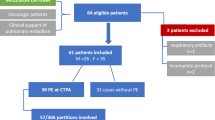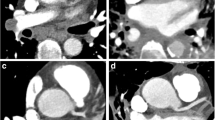Abstract
The aim of this study was to investigate the variation of the size of pulmonary vein ostia during cardiac cycle using ECG-gated multi-detector row CT (MDCT). Nineteen patients were included in this study. Transaxial images at the level of right inferior pulmonary vein (RIPV) were reconstructed in increments of 5%. The ostial diameter of RIPV was measured, the reconstruction windows showing maximal and minimal diameters were selected. The ostial areas of four pulmonary veins were measured at axial image sets of two selected reconstruction windows. The measurement of RIPV revealed that the maximal diameter (1.50±0.32 cm) was generally 35% and the minimal diameter (1.28±0.28 cm) was usually at 85%. The measurement of ostial areas showed that the ostia enlarged at the end of ventricular systole when compared with those at the end of ventricular diastole, by the factors of 1.44±0.55 for the right superior, 1.25±0.23 for the right inferior, 1.45±0.81 for the left superior, and 1.31±0.26 for the left inferior pulmonary vein (P<0.05). The size of the pulmonary vein ostia is variable during the cardiac cycle and the measurement of the pulmonary veins should always be in the same phase of the cardiac cycle during the follow-up of patients.



Similar content being viewed by others

References
Haissaguerre M, Jais P, Shah DC et al. (1998) Spontaneous initiation of atrial fibrillation by ectopic beats originating in the pulmonary vein. N Engl J Med 339:659–666
Chen SA, Hsieh MH, Tai CT et al. (1999) Initiation of atrial fibrillation by ectopic beats originating from the pulmonary veins electrophysiological characteristics, pharmacologic responses, and effects of radiofrequency ablation. Circulation 100:1879–1882
Haissaguerre M, Jais P, Shah DC et al. (2000) Electrophysiological end point for catheter ablation of atrial fibrillation initiated from multiple pulmonary venous foci. Circulation 101:1408–1417
Jais P, Weerasooriya R, Shah DC et al. (2002) Ablation therapy for atrial fibrillation: past, present, and future. Cardiovasc Res 54:337–346
Rajagopalan B, Bertram CD, Stallard T et al. (1979) Blood flow in pulmonary veins: simultaneous measurement of their dimensions, intravascular pressure, and flow. Cardiovasc Res 13:684–692
Lin W-S, Prakash VS, Tai C-T et al. (2000) Pulmonary vein morphology in patients with paroxysmal atrial fibrillation initiated by ectopic beats originating from the pulmonary vein: implications for catheter ablation. Circulation 101:1274–1281
Kato R, Lickfett L, Meininger G et al. (2003) Pulmonary vein anatomy in patients undergoing catheter ablation of atrial fibrillation: lessons learned by use of magnetic resonance imaging. Circulation 107:2004–2010
Ghaye B, Szapiro D, Dacher FN et al. (2003) Percutaneous ablation for atrial fibrillation: the role of cross-sectional imaging. Radiographics 23:19–33
Sairanen H, Louhimo I, Tolppanen EM (1986) Pulmonary vein diameter in normal children. Pediatr Cardiol 6:259–261
Robida A (1990) Diameters of pulmonary veins in normal children: an angiographic study. Cardiovasc Intervent Radiol 12:307–309
Yu WC, Hsu TL, Tai CT et al. (2001) Acquired pulmonary vein stenosis after radiofrequency catheter ablation of paroxysmal atrial fibrillation. J Cardiovasc Electrophysiol 12:887–892
Masui T, Seelos KC, Kersting-Sommerhoff BA et al. (1991) Abnormality of the pulmonary veins: evaluation with MR imaging and comparison with cardiac angiography and echocardiography. Radiology 181:645–649
Wittkampf FH, Vonken E-J, Derksen R et al. (2003) Pulmonary vein ostium geometry: analysis by magnetic resonance angiography. Circulation 107:21–23
Yang M, Akbari H, Reddy GP et al. (2001) Identification of pulmonary vein stenosis after radiofrequency ablation for atrial fibrillation using MRI. J Comput Assist Tomogr 25:34–35
Dill T, Neumann T, Ekinci O et al. (2003) Pulmonary vein diameter reduction after radiofrequency catheter ablation for paroxysmal atrial fibrillation evaluated by contrast-enhanced three-dimensional magnetic resonance imaging. Circulation 107:845–850
Kopp AF, Kuttner A, Trabold T, Heuschmid M, Schroder S, Claussen CD (2003) Cardiac and vascular MDCT: thoracic imaging. Eur Radiol 13(Suppl 5):M73–M81
Maksimovic R, Cademartiri F, Scholten M, Jordaens LJ, Pattynama PM (2004) Sixteen-row multislice computed tomography in the assessment of pulmonary veins prior to ablative treatment: validation vs conventional pulmonary venography and study of reproducibility. Eur Radiol 14:369–374
Cirillo S, Bonamini R, Gaita F et al. (2004) Magnetic resonance angiography virtual endoscopy in the assessment of pulmonary veins before radiofrequency ablation procedures for atrial fibrillation. Eur Radiol 14(11):2053–2060
Cronin P, Sneider MB, Kazerooni EA, Kelly AM et al. (2004) MDCT of the left atrium and pulmonary veins in planning radiofrequency ablation for atrial fibrillation: a how-to guide. Am J Roentgenol 183:767–778
Pannu HK, Flohr TG, Corl FM, Fishman EK (2003) Current concepts in multi-detector row CT evaluation of the coronary arteries: principles, techniques, and anatomy. Radiographics 23:111–125
Author information
Authors and Affiliations
Corresponding author
Rights and permissions
About this article
Cite this article
Choi, S.I., Seo, J.B., Choi, S.H. et al. Variation of the size of pulmonary venous ostia during the cardiac cycle: optimal reconstruction window at ECG-gated multi-detector row CT. Eur Radiol 15, 1441–1445 (2005). https://doi.org/10.1007/s00330-005-2694-0
Received:
Revised:
Accepted:
Published:
Issue Date:
DOI: https://doi.org/10.1007/s00330-005-2694-0



